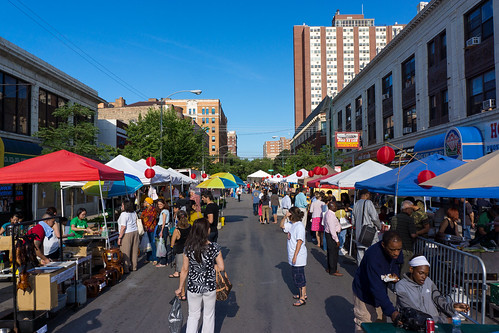View Larger Map
Looking east at the Red Line tracks on Bryn Mawr.
The Active Transportation Alliance’s recently released list of 20 proposed streets for partial or total pedestrianization continues to spark conversation about whether Chicago streets should be as car-dominated as they are. One of the roadways mentioned was Bryn Mawr between Sheridan and Broadway, and today DNAinfo ran quotes from various Edgewater residents, community leaders, and merchants who were horrified at the idea of completely banning cars from the bustling retail strip.
"NO! Bryn Mawr will not be closed to traffic between Broadway and Sheridan," said Sheli Lulkin, president of a the Association of Sheridan Condo/Co-op Owners, in an email, adding that Bryn Mawr had been built to carry thousands of cars a day. Since the neighborhood was laid out in the 1880s, that’s almost certainly not the case. "What are we gonna do," she asked, "throw everything out and start all over again because some bike riders want to widen the street?"
While Lulkin seems a bit unclear on the concept, some of the people interviewed did have legitimate concerns about how total pedestrianization might affect the burgeoning business district. Anchored by the Red Line’s Bryn Mawr station, the strip is packed with diverse shops, restaurants and theaters. East of the tracks is the Bryn Mawr historic district, featuring several handsome art deco buildings.
View Larger Map
Drivers use this two-lane street to get from Lake Shore Drive to Ridge, U.S. Route 14. However, it would be just as easy for them to exit the drive a block north at its northern terminus and access Ridge via Hollywood, a four-lane road with little or no retail. Moving those unnecessary cars off Bryn Mawr would make walking safer and more pleasant. Still, it’s understandable that business owners would be wary of losing access and parking for their patrons who drive, even if it may be the case that a larger number are coming on foot, by train, bus, or bike.
Perhaps banning all motor vehicles from Bryn Mawr at all times wouldn’t make sense, but that’s only one of a number of possible scenarios for creating a more pedestrian-, transit- and bike-friendly street. The strip could be closed to cars but open to buses, like Denver’s successful 16th Street transit mall. Or maybe the LSD ramps at Bryn Mawr could be closed some or all of the time to reduce, but not eliminate, car traffic on the strip.
Alternately, the street could be closed to cars only during the summer, or on weekends, or during the evenings. The Asian-focused Argyle business strip, another busy retail district six blocks south, also centered on a Red Line stop, was partially pedestrianized on Thursday evenings last summer for a wildly successful night market.
Perhaps instead of closing Bryn Mawr itself, a block of Kenmore or Winthrop north or south of the street could be closed to cars, although open to bikes, to create permanent pedestrian space. That could become a major asset for the neighborhood, much like Lincoln Square’s beloved Kempf Plaza.
Another possibility would be to narrow the travel lanes on Bryn Mawr to make room for wider sidewalks and/or bike lanes. The street is generally 40-42 feet wide, so there's plenty of room to work with, especially if one of the parking lanes was converted.
48th Ward Alderman Harry Osterman is open to the idea of additional traffic calming on the street, his assistant Dan Luna told DNA. Raised crosswalks that double as speed tables, which currently exist by Kempf Plaza, could work well on this stretch of Bryn Mawr. The area would certainly benefit from some additional public space – perhaps a few parking spots could be converted into a People Spot mini park to provide some much-needed greenery.
There are tons of possibilities for a less car-focused, more people-oriented Bryn Mawr. Rather than slam the door on the topic, why not keep an open mind and continue the conversation?





